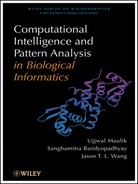Contents
Chapter 1: Computational Intelligence: Foundations, Perspectives, and Recent Trends
1.1 What is Computational Intelligence?
1.2 Classical Components of CI
1.3 Hybrid Intelligent Systems in CI
Chapter 2: Fundamentals of Pattern Analysis: A Brief Overview
2.2 Pattern Analysis: Basic Concepts and Approaches
2.5 Unsupervised Classification or Clustering
Chapter 3: Biological Informatics: Data, Tools, and Applications
Chapter 4: Promoter Recognition Using Neural Network Approaches
4.2 Related Literature /Background
4.3 Global Signal-Based Methods for Promoter Recognition
4.4 Challenges in Promoter Classification
Chapter 5: Predicting Microrna Prostate Cancer Target Genes
5.3 Prediction software for miRNAs
5.6 Automatic parameter tuning
5.8 Discussion and Conclusions
Chapter 6: Structural Search in RNA Motif Databases
6.2 The Search Engine on RmotifDB
6.3 The Search Engine Based on BlockMatch
Chapter 7: Kernels on Protein Structures
7.5 Kernels on Protein Structures
8.3 Cross comparison of active and inactive forms of closely related kinases
8.4 Comparison of the active states of homologous kinases
Chapter 9: Kernel Function Applications in Cheminformatics
9.4 Alignment Kernels with Pattern-based Features
9.5 Alignment Kernels with Approximate Pattern Features
9.6 Matching Kernels with Approximate Pattern-based Features
9.7 Graph Wavelets for Topology Comparison
Chapter 10: In Silico Drug Design Using a Computational Intelligence Technique
10.3 Experimental Results and Discussion
Part IV: Microarray Data Analysis
Chapter 11: Integrated Differential Fuzzy Clustering for Analysis of Microarray Data
11.2 Clustering Algorithms and Validity Measure
11.3 Differential Evolution based Fuzzy Clustering
11.5 Integrated Fuzzy clustering with Support Vector Machines
Chapter 12: Identifying Potential Gene Markers Using Svm Classifier Ensemble
12.2 Microarray Gene Expression Data
12.3 Support Vector Machine Classifier
12.5 Data Sets and Preprocessing
12.7 Discussion and Conclusions
Chapter 13: Gene Microarray Data Analysis Using Parallel Point Symmetry-Based Clustering
13.2 Symmetry- and point symmetry-based distance measures
13.3 Parpsbkm clustering implementation
13.5 Test for Statistical Significance
Chapter 14: Techniques For Prioritization of Candidate Disease Genes
14.2 Prioritization Based on Text-Mining With Reference to Phenotypes
14.3 Prioritization with no direct reference to phenotypes
14.4 Prioritization using interaction networks
14.6 Fusion of data from multiple sources
14.7 Conclusions and open problems
Chapter 15: Prediction of Protein–Protein Interactions
15.5 Driving Forces for the Formation of PPIs
